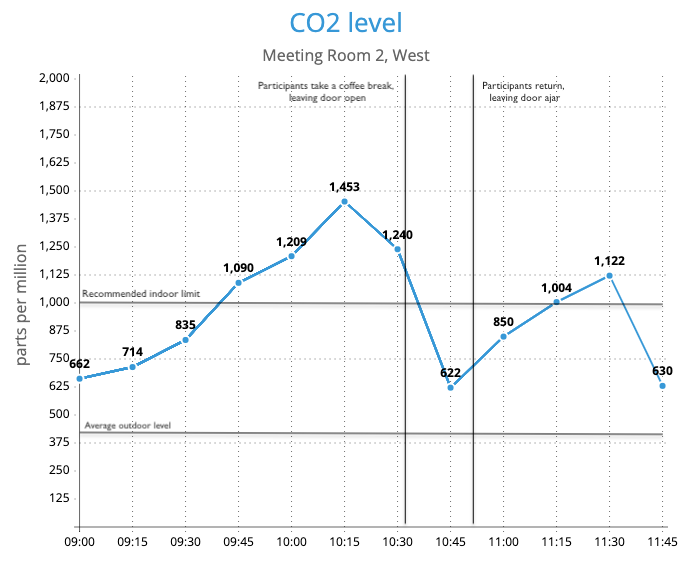One of my previous employers had a big luxurious presentation theatre. There was a proper stage with lighting and a decent sound system. The seats were plush, like our local cinema. It was a good facility.
Trouble was, people had a tendency to feel sleepy in afternoon meetings. Some even fell asleep in there, usually in full view of the presenter. Often that was a senior manager.
It was claimed that people weren’t getting enough sleep or that they’d eaten too much during lunch. Falling asleep was seen as a shameful thing
The thing is, we now know the cause. The theatre was in a central part of the building with no external walls. It was near reception so when people were presenting or there was a video screening we kept the doors closed.
You’ve probably guessed the problem already. With little airflow and a room full of inconveniently aspirating humans, the CO2 levels quickly rose to the point that performance was inhibited.
Small or densely populated rooms build up both heat and carbon dioxide from our bodies at a rate that would probably surprise you. There is a growing body of evidence that suggests that the quality of indoor air has a significant impact on decision-making.
Isn’t it a bit stuffy in here?
We’ve become a lot better at insulating our buildings. It has helped us to reduce energy consumption from heating (and cooling). This has had the unintended consequence of allowing for a build-up of gasses and other substances released by humans.
It’s not just the human-related emissions we need to be aware of. With less ventilation, the organic compounds emitted by air fresheners, cleansing fluids, new furniture and carpets can all become problematic.

A normal level of carbon dioxide is around 300 – 900 parts per million. As soon as it gets beyond 1000 people start to feel drowsy. Whilst running our trials of Entelligently – the workplace monitoring software – we sometimes detected figures in meeting rooms in excess of 2000 ppm. At those levels, the symptoms can include headaches and dizziness as well as sleepiness. This is why we feel sleepy in afternoon meetings.
How does this affect our workers?
Even before the drowsiness takes hold, mental processes are becoming impaired. A famous study at Lawrence Berkeley National Laboratory saw subjects exposed to a range of concentrations of Carbon Dioxide and found that the greater the concentration the worse the performance.
A follow-up study at Harvard demonstrated how workplace performance declined significantly as CO2 levels increased from 550ppm to 1400ppm. It is crucial to note that this was not conducted under some weird, theoretical condition. It was precisely under those conditions in which people are working every day.
So what should we do if we feel sleepy in afternoon meetings?
Given that most of the problems are caused by a lack of ventilation, something as simple as opening the meeting room door is a massive help. Again, during our testing of Entelligently just holding a door open for around 15 seconds was enough to reduce the concentration of CO2 to the ambient building concentration of around 500ppm.
Permanent solutions would include the introduction of mechanical ventilation. For those buildings fortunate enough to have a modern building management system, software such as Entelligently can automate the process of venting, opening windows, or, at its most basic, sending a push notification to ask the meeting booker to open the door for a while.
Failing this your two choices are to remember to keep opening the door every 20 minutes to remove the CO2 and replenish oxygen or to accept that people are going to become increasingly crabby and sleepy.
I’d vote for fresh air every single time!
You can read more about Entelligently and the intelligent adaptive workplace here.
Get in touch at david.patterson@kn-i.com if you would like to try the Entelligently software in your workplace.
